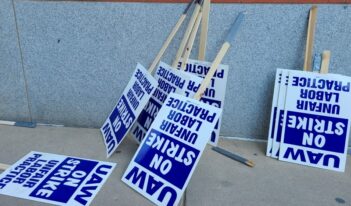
To the ire of employers, proposal would allow employees to vote to unionize in less than half the current time.
Some employers are worried that the National Labor Relations Board’s (NLRB) newly proposed rule would allow unions to ambush companies with “quickie” elections before employees were fully informed about what unionizing would entail.
The NLRB hopes, however, that speeding up employee representation elections and giving union organizers more access to employee contact information will modernize the election process and make it fairer for everyone involved.
The NLRB recently closed the comment period on a proposed rule that would significantly decrease the currently required 25-day waiting period between a union’s filing a petition to unionize and the employees’ vote on representation. The rule would also abolish companies’ ability to request a pre-election review of the petition to delay a vote and require companies to provide union organizers’ employee e-mail addresses and phone numbers within two days after notice of the filing.
These changes would allow unions to hold an election as soon as 10 days after filing a petition.
The NLRB stated that the proposed rule would “remove unnecessary barriers to the fair and expeditious resolution of questions concerning representation, to increase transparency and uniformity across regions…[and] to eliminate unnecessary litigation.”
The proposed rule mirrors the regulation the NLRB promulgated in 2011. A federal district court struck down that rule the next year because the NLRB lacked enough members for a quorum. Absent exceptional circumstances—which were not present in this case—the NLRB must have at least three members to qualify as a quorum in order to officially promulgate a rule. When promulgating the 2011 rule, only two NLRB members participated, one short of the necessary amount.
The district court’s decision invalidating the rule emphasized that the court expressed no opinion on the legality of the regulation’s substance. “It may well be,” the district court found, “that, had a quorum participated in its promulgation, the final rule would have been found perfectly lawful.”
House Republicans, led by House Education & the Workforce Committee Chair John Kline (R-MN) and subcommittee Chair Phil Roe (R-TN), requested a 30-day extension on the current proposed rule’s comment period. Kline said, “At a recent meeting with [NLRB] Chairman Mark Pearce, we laid out our concerns…However, it’s exceedingly obvious the board is determined to advance this radical scheme no matter the damage inflicted on our nation’s workplaces.”
The NLRB denied Kline and Roe’s request, stating that the two comment periods provided ample time for all interested parties. The NLRB also emphasized that more than 70,000 comments from the 2011 proposal would be incorporated in the current review process.
Supporters of the proposal applauded the NLRB’s efforts to streamline the voting process. Richard Trumka, President of the American Federation of Labor and Congress of Industrial Organizations (AFL-CIO), stressed that workers should be able to vote for union representation in a timely manner. He said, “[T]he current NLRB election process is riddled with delay and provides too many opportunities for employers to manipulate and drag out the process through costly and unnecessary litigation and deny workers a vote.”
The Communication Workers of America echoed Trumka’s sentiments, arguing, “Reform of the NLRB election rules is long overdue. For too long, employees who have wanted the benefits of union representation have watched in frustration and fear as the agency charged with protecting their right to make that choice appeared powerless to do its job.”
House Minority Leader Nancy Pelosi (D-CA), who shared the union leaders’ opinions, emphasized that “the NLRB proposed commonsense reforms that are a step toward ensuring fairness for workers as they exercise their fundamental right to decide whether to join a union. The current process has stacked the deck against workers.”
Opponents of the proposed rule, however, have fiercely attacked the changes as creating a way for unions to “ambush” companies through “quickie elections.”
Geoff Burr, a Vice President for Associated Builders and Contractors, Inc., a national trade association representing 22,000 members, was disappointed the NLRB reconsidered the rule after the 2012 court ruling. He stated, “Shortening the election period does nothing to ensure a fairer election and it is clearly not necessary to help the NLRB meet its self-imposed goal for election timeframes. In addition, it denies employers their rights to free speech and employees the opportunity to make a fully informed decision.”
Randel Johnson, a Senior Vice President at the U.S. Chamber of Commerce, also attacked the proposal as a “not so cleverly disguised effort to restrict the ability of employers to express their views during an election campaign, to inform employees of the pros and cons of unionization.”
The proposed rule’s comment period recently closed, with over 74,000 comments submitted for consideration.



